
![]()
The Fell Pony
by The Fell Pony Society

![]()
The Fell Pony
by The Fell Pony Society
![]()
Early History
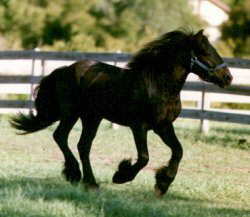 |
The Wild European pony migrated to the British Isle approx 1500BC. One type predominated in northern England, and can be credited as the progenitor of the Fell Pony. When crop farming and animal husbandry replaced hunting, wild ponies were drastically reduced to conserve available pasture. In northern England ponies became almost extinct in some parts and those that remained existed in small pockets which encouraged inbreeding and so led to regional characteristics.
By the time the Romans were well established in the North there must have been a definite type of dark coloured pony, standing perhaps just over 13hh, bred within the local catchment area of Hadrian's Roman Wall. Bred from Fresian stallions and indigenous pony mares the resulting progeny inherited the strength and quiet nature of the Fresian along with the hardiness, thriftiness and pony character of the north country ponies. Most of the ponies were black, dark brown or bay, white markings were very rare, and as the size of the pony was governed by the quality of grazing, it is unlikely that ponies exceeding 13hh could have survived on the northern moorland.
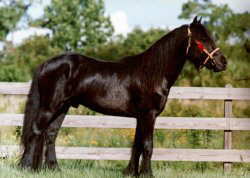 |
The early fell pony type of animal made an ideal fell pony, it was strong and sure-footed, placid in nature and not too big to make loading and unloading difficult while being up to the weight of a full load. Unlike the small native ponies of pre-Roman times, the improved Fell type was large enough for a man to ride and was recognised as a dual-purpose breed.
The Vikings used the ponies for ploughing and sledge pulling, the Normans for shepherding, by the thirteenth century there was a brisk trade in wool to Belgium, and local ponies were used to transport merchandise around the country, old packways can still be seen today.
The advent of the Industrial Revolution was a comparatively rapid innovation but one that, directly or otherwise, affected the whole country. Its initial effect on the Fell Pony came by way of iron-ore mines situated in the north-west of England. Once excavated the ore had to be transported across country to the smelting works of the north-east coast, and because of the uneven topography of the country and complete lack of suitable roads and canals, other feasible methods of transport had to be found. The coming of the railways meant redundancy for many of the pony teams and their dependant tradesmen, within an incredibly short period of time hundreds of ponies disappeared, many being sold abroad for slaughter. Fortunately the Fell Pony was still surviving in it's native Lakeland home, and despite it's dramatic rise and fall at the hands of the industrialists, as a breed it was quite unchanged, for the disbanding of pony teams had not affected the true pony breeding stock at home on the Cumbrian hills.
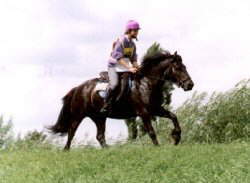 |
The affluent 1950's saw the beginnings of the popularity of riding for pleasure, a pursuit that has gained momentum ever since and in its wake guaranteed the future of many native breeds. The number of ponies being registered with the Fell Pony Society has risen gradually ever since.
Ref: "The Fell Pony" - Clive Richardson 1981, 1990
The Fell Pony Today
There is a demand for an all-round family pony capable of carrying all members of the family and versatile enough to fulfil a wide variety of jobs previously done by two or three more specialised animals. In this capacity the Fell Pony is ideal being well up to the weight of a heavy adult, yet quiet enough and not too big for a child. In many respects the present day family Fell Pony is mainly continuing to apply to modern demands, the same adaptability which endeared it to the Lakeland farmers of approximately a hundred years ago.
As a hack and general riding pony, the Fell's fast walk and easy paces make it a pleasant and comfortable ride, and its sure footedness ensures a safe passage over the roughest country. It is possible to ride a Fell pony through places where other lighter bred ponies would come to grief and Fells seem to have a sixth sense which alerts them to possible danger, they seem to know which is the soundest track through soft marshy ground or the safest descent of a rocky hillside.
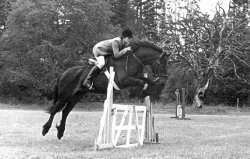 |
To test these qualities The Fell Pony Society holds an annual performance trial where the course comprises a varied range of difficult terrain including steep and twisting hills, boggy ground, a watercrossing and several natural hazards such as fallen logs and the like. Fell Ponies are generally creditable jumpers, particularly across country, being both agile and very clever on their feet, which is a valuable asset when jumping "blind" when out hunting. Although most lack the scope to make top class jumping ponies, their abilities are well up to local shows or Pony Club events where many prove their worth.
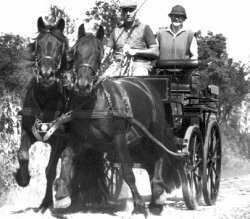 |
The rediscovery of Driving as a recreational sport has given the Fell Pony the means of continuing in a job which it has traditionally done for centuries. They are well suited to this work, having great stamina. The fact that the Fell Ponies breed very true to type makes it very easy to find matched pairs than is the case with many of the other breeds. Their main limitation in competitive work is their lack of speed, but their tireless energy compensates amply and several acquit themselves well in combined driving events. A few Fell Ponies are still used in Scotland carrying the stags and grouse panniers down from the moors. Some of HM The Queen's ponies are sometimes used for this purpose at Balmoral while others are used for both riding and driving by the Royal Family. Large numbers of Fell Ponies are used in riding and trekking stables throughout the country because of their docile temperaments and useful size. The Riding for the Disabled movement employs a number as mounts for both disabled children and adults.
All these attributes make the Fell Pony an Ideal Family Pony.
Ref: The history of the Fell Pony & The Modern Fell Pony - Fell Pony 2000
|
The Fell Pony Society Patron: Her Majesty The Queen
Secretary & Treasurer: Mrs J A Slattery The Fell Pony Society's aim is to foster and keep pure the old breed of pony which has roamed the northern fells for years and to circulate knowledge and general information about the pony breed. Membership details of the Society are available from the above office. The Society deals with the Registration of Ponies, applications for Membership, export matters, produces regular newsletters, lists of ponies for sale and also has a regular calendar of events, if you would like any information about the events - please contact the office. Events and Shows for your Diary
* Provisional Dates |
Click Here
or send an email to
joynext@field-galleries.co.uk
to be notified when the next issue
of the magazine is published
If you wish to get in touch about another matter then please use the contact form